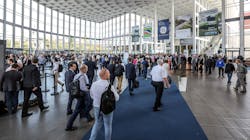InnoTrans 2022 final report: Successful summit for rail transport and mobility
Sustainable mobility is the dominant theme in the industry – InnoTrans 2022 clearly confirmed that. From Sept. 20-23, 2022, all the leading manufacturers and actors gathered at the international trade fair for transport technology and mobility in Berlin. Exhibitors and visitors drew a positive conclusion after the four-day event. 2,834 exhibitors from 56 countries presented the mobility sector’s entire range of products and services on the Berlin Exhibition Grounds, which were fully booked. Among the exhibits were 250 world innovations, 128 vehicles and 14 buses. Alternative drive systems, battery-electric and fuel cell-powered buses and trains were the main topics at the trade fair.
137,394 international visitors from 131 countries came to the German capital to find out about this uniquely wide-ranging overview of the industry’s products and services.
InnoTrans unites markets across borders
This year’s InnoTrans once again lived up to its reputation as an international forum and driving force of the industry.
At InnoTrans, Dr. Richard Lutz, CEO of Deutsche Bahn, and Oleksander Kamyshin, CEO of Ukrsalisnyzja (UZ), the state-run Ukrainian rail network, signed a memorandum of understanding. The agreement guarantees UZ support for reconstruction after the war, and includes collaboration on expanding goods supply corridors and terminal capacity as well as wide-ranging consultation services for introducing European rail operation and management standards.
At InnoTrans, Poland’s rail vehicle manufacturer Pesa and the mineral oil company and fuel station operator PKN Orlen reached an agreement to collaborate on hydrogen-powered rail vehicles. As a group, the two companies will put together an offer for rail transport companies that will include supplying rolling stock as well as hydrogen and refueling solutions.
At InnoTrans, Saudi Arabia was able to move forward with ambitious plans for expanding its rail network. The country had already signed agreements with Deutsche Bahn and Siemens, said Dr. Bashar Khalid Al Malik, CEO of the Saudi Arabian Railway Company, at the trade fair. With Deutsche Bahn, the project included a knowledge transfer, while with Siemens the topic was also ticketing, he said.
Positive results ensure a good mood among exhibitors
According to a representative survey, exhibitors and trade visitors gave a positive assessment of their attendance at the trade fair. 90 per cent of trade visitors were highly satisfied with their visit. 94 per cent of exhibitors had a positive overall impression of the trade fair. At 91 per cent respectively, both groups said they would readily recommend InnoTrans to others. A high percentage of trade visitors attended in a decision-making capacity, with almost 50 per cent occupying a senior position in their company. 57.3 per cent of trade visitors came from abroad. Trade visitors from Europe showed particularly keen interest in the trade fair. Almost two-thirds came from the EU. A high proportion of exhibitors (around 18 per cent) reported successful business deals. Nine out of ten exhibitors expected good follow-up business.
Sustainable mobility and comfort for passengers
Numerous exhibitors made use of the rail track and outdoor display area at InnoTrans to draw maximum attention to their world innovations. Among manufacturers, sustainable mobility was the dominant theme. On the rail track and outdoor display area, Siemens Mobility presented the Mireo Plus H, the next generation of hydrogen-powered trains, as well as the Mireo Plus B, which features a modular high-performance battery system. For the first time Stadler displayed its hydrogen-powered FLIRT H2 multiple-unit train for the American passenger rail market. Visitors could even witness Alstom’s Coradia iLint hydrogen-powered passenger train live, which is currently operating twice daily from Berlin-Spandau to Berlin-Ostbahnhof. Hitachi presented its Blues Train, which combines diesel, electric and battery-electric drive systems. Vossloh exhibited its DM 20 hybrid locomotive, which can also rapidly switch operating modes and energy systems.
Deutsche Bahn was represented with several innovative trains (Ideenzug). The City version was incorporated in the middle carriage of Hamburg’s digital S-Bahn. That particular innovative train is still a future concept. However, the one operated by Südostbayernbahn, a double-decker carriage, is real and was exhibited by DB Regio on the outdoor display area.
New drive systems on the Bus Display
Once again, one of this year’s highlights was the Bus Display, featuring 14 buses being driven on the 500-metre long demonstration course in the Summer Garden. For the first time Solaris presented its Solaris Urbino 18 hydrogen, an 18-metre long bus with hydrogen as its main energy source. The ŠKODA H’CITY also uses hydrogen as a sustainable drive system. Van Hool was represented with its A12 electric bus. Ebusco presented its all-electric city bus 3.0 on the Bus Display. Also being shown was the Modell 2.2, the new electric bus for Berliner Verkehrsbetriebe (BVG).
Supporting program with all the latest information
An outstanding supporting program featuring wide-ranging discussion rounds, lectures and events gave visitors an opportunity to find out about all the latest topics and trends in the mobility sector, including driverless rail vehicles, tunnel construction, smart public transport and innovative passenger experiences. New: recordings of the livestreamed events are available after the trade fair on the InnoTrans Plus online portal.
